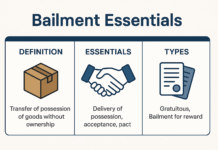State fully exceptions to the rule that there is no implied condition or warranty or condition as to quality or fitness for any particular pupose of goods applied under a contract of sale.
The cornerstone principle in the sale of goods, often summarized by the maxim “caveat emptor” (let the buyer beware), generally implies that the buyer is responsible for ensuring the goods they purchase meet their required quality and fitness for a specific purpose. The common law tradition and Section 16 of the Sale of Goods Act embody this idea, stating that there is typically no implied warranty or condition from the seller regarding the quality or suitability of the goods for a particular purpose. The onus is on the buyer to satisfy themselves before making the purchase.
However, recognizing the limitations and potential unfairness of a strict “buyer beware” approach in all situations, the Sale of Goods Act carves out significant exceptions to this general rule. These exceptions introduce implied conditions that place certain responsibilities on the seller regarding the quality and fitness of the goods they supply. Let’s delve into these crucial exceptions:
The General Rule: Buyer’s Responsibility (Section 16)
Section 16 of the Sale of Goods Act lays down the primary rule: “Subject to the provisions of this Act and to any other law for the time being in force, there is no implied warranty or condition as to the quality or fitness for any particular purpose of goods supplied1 under a contract of sale…“
This means that unless there is an express agreement or a specific exception applies, the seller does not automatically guarantee that the goods are of a certain quality or suitable for the buyer’s intended use. The buyer is expected to exercise their own judgment and due diligence. If they fail to do so, they generally cannot later complain that the goods are not up to their expectations.
Example: If a buyer purchases a used car after inspecting it, they cannot later return it simply because they discover minor wear and tear that they should have noticed during their examination. The principle of caveat emptor applies here.
Exceptions to the Rule of No Implied Condition or Warranty:
Despite the general rule of caveat emptor, Section 16 itself outlines key exceptions that imply certain conditions regarding the quality and fitness of goods:
1. Implied Condition as to Fitness for Buyer’s Purpose (Section 16(1))
This is a significant exception that shifts the responsibility to the seller under specific circumstances:
- Rule: Where the buyer, expressly or by implication, makes known to the seller the particular purpose for which the goods are required, so as to show that the buyer relies on the seller’s skill or judgment, and the goods are of a description which it is in the course of the seller’s business to supply2 (whether they are the manufacturer or producer or not), there is an implied condition that the goods shall be reasonably fit for such purpose.
- Essential Conditions for this Exception to Apply:
- Disclosure of Purpose: The buyer must, explicitly or implicitly, inform the seller of the specific reason they need the goods. A general purpose might not suffice.
- Reliance on Seller’s Skill or Judgment: The buyer must demonstrate that they are relying on the seller’s expertise or assessment in choosing suitable goods for their stated purpose. This reliance is often inferred when the seller is a dealer in such goods.
- Seller’s Business to Supply: The goods must be of a type that the seller ordinarily deals with in their business.
- Disclosure of Purpose: The buyer must, explicitly or implicitly, inform the seller of the specific reason they need the goods. A general purpose might not suffice.
- Example (Based on Grant v. Australian Knitting Mills): A person buying woolen underpants from a retailer implicitly makes known the purpose (wearing them). If they develop dermatitis due to a hidden defect in the fabric, there’s a breach of the implied condition of fitness because they relied on the retailer to supply wearable undergarments.
- Limitation: Sale Under a Patent or Trade Name (Proviso to Section 16(1))
- There is no implied condition as to fitness for a particular purpose if the contract is for the sale of a specified article under its patent or trade name, and the buyer relies on their own judgment of the article’s suitability. The law assumes the buyer is relying on the brand’s reputation rather than the seller’s skill.
- However: If the buyer still relies on the seller’s recommendation even when purchasing under a trade name (as seen in Baldry v. Marshall, where a specific car was recommended for touring), the implied condition of fitness can still apply. The mere mention of a trade name doesn’t automatically exclude the buyer’s reliance on the seller’s expertise.
- There is no implied condition as to fitness for a particular purpose if the contract is for the sale of a specified article under its patent or trade name, and the buyer relies on their own judgment of the article’s suitability. The law assumes the buyer is relying on the brand’s reputation rather than the seller’s skill.
- Disclosure of Specific vs. General Purpose: If the buyer only discloses a general purpose, and the goods are fit for that general purpose, the seller is not liable if the goods don’t meet a specific, undisclosed requirement.
- Example (Based on Re Andrew Yule & Co.): Hassion cloth was bought for packing. It was suitable for general packing but not for packing fruits due to an unusual smell. Since the specific purpose of packing fruits was not disclosed at the time of purchase, the buyer could not reject the cloth.
2. Implied Condition as to Merchantable Quality (Section 16(2))
This exception focuses on the basic standard of quality expected from goods:
- Rule: Where goods are bought by description from a seller who deals in goods of that description (whether they are the manufacturer or producer or not), there is an implied condition that the goods shall be of merchantable quality.
- Essential Conditions:
- Sale by Description: The goods must be sold based on a description (e.g., “cotton shirts,” “plastic toys”). Even a sale over the counter where the buyer asks for a specific item can be considered a sale by description (as seen in Godley v. Perry).
- Seller Deals in Such Goods: The seller must be someone who regularly trades in goods of that description.
- Sale by Description: The goods must be sold based on a description (e.g., “cotton shirts,” “plastic toys”). Even a sale over the counter where the buyer asks for a specific item can be considered a sale by description (as seen in Godley v. Perry).
- Meaning of “Merchantable Quality”: This term implies that the goods should be of a quality that is commercially acceptable under the given description. Generally, it means:
- For Resale: The goods must be capable of being resold in the market under the same description without any significant defects.
- For Self-Use: The goods must be reasonably fit for the purpose for which goods of that kind are commonly bought and used.
- For Resale: The goods must be capable of being resold in the market under the same description without any significant defects.
- Limitation: Examination by Buyer (Proviso to Section 16(2))
- If the buyer has examined the goods, there is no implied condition as regards defects which such examination ought to have revealed.3 The caveat emptor principle still applies to defects that a reasonable inspection would have uncovered.
- Example (Based on Thornett and Fehr v. Beers & Sons): A buyer inspected the exterior of glue casks but didn’t ask to open them. The glue inside was defective. The court held that the seller was not liable for defects that a proper examination (opening the casks) would have revealed.
- If the buyer has examined the goods, there is no implied condition as regards defects which such examination ought to have revealed.3 The caveat emptor principle still applies to defects that a reasonable inspection would have uncovered.
3. Implied Conditions or Warranties by Usage of Trade (Section 16(3))
Customs and practices prevalent in a particular trade can also imply conditions or warranties regarding the quality or fitness of goods, especially when the contract is silent on those aspects. The law assumes that parties contracting within a trade do so with reference to these known usages.
- Example (Based on Jones v. Bowden): In the auction sale of drugs, a trade usage existed to disclose if drugs were sea-damaged. A seller’s silence on this was held to be an implied representation that the drugs were not sea-damaged.
4. Express Conditions or Warranties Do Not Negate Implied Ones (Unless Inconsistent)
Parties are free to include explicit conditions and warranties in their contracts. However, these express terms do not automatically negate the implied conditions or warranties under the Sale of Goods Act unless the express terms are inconsistent with the implied ones. The law provides a baseline of quality and fitness that express terms must clearly contradict to override.
- Example (Based on Bombay Burma Trading Corpn v. Aga Mahomed): An express condition requiring railway sleepers to be approved by the railway’s experts did not exclude the implied condition that the sleepers must also be of merchantable quality.
Conclusion: The Erosion of Caveat Emptor and the Rise of Caveat Venditor
The numerous and significant exceptions to the rule of caveat emptor clearly indicate a modern shift in legal and commercial perspectives. While the buyer still bears some responsibility to exercise reasonable diligence, the law increasingly places obligations on the seller to ensure the quality and fitness of the goods they offer, especially when the buyer relies on their expertise or when goods are sold by description.
As aptly stated by Chief Justice Best in Jones v. Bright, the exceptions to caveat emptor have become so prominent that the rule has almost transformed into “caveat venditor” – let the seller beware. This reflects the complexities of modern trade, the specialized knowledge of sellers regarding their products, and the need to protect consumers from latent defects and unsuitable goods. The emphasis has shifted towards ensuring fair dealing and holding sellers accountable for the quality and fitness of what they sell.
















